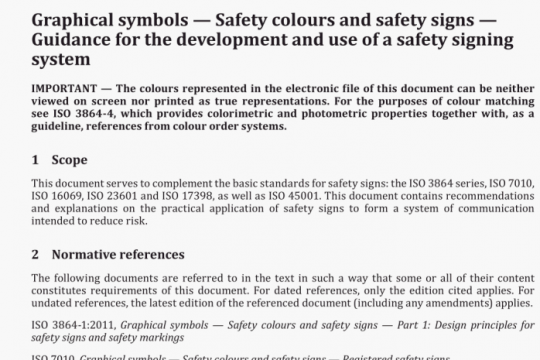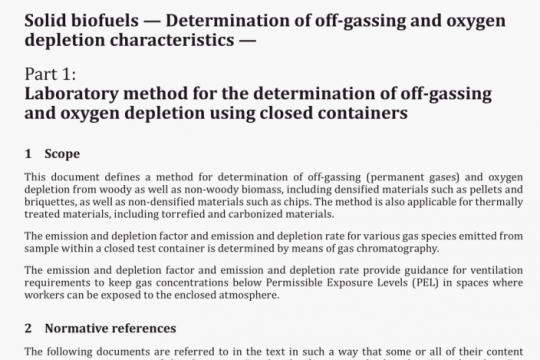BS ISO 23781 pdf free download
BS ISO 23781-2021 pdf free download.Operating procedures of pig slaughtering.
5.3 Bleeding
5.3.1 After stunning, the pigs shall be immediately bled. For electrical stunning, the duration from stunning to bleeding should not exceed 30 s. When head-only electrical stunning is used, the duration should be less than 15 s. This recommendation is not necessary for high-concentration gas stunning which permits a long anaesthesia period.
5.3.2 Point the knife tip to about 0,5 cm to 1 cm to the right of the centre of the throat, and stab in the direction of the heart. Then make a cross cut and keep moving the knife to cut the carotid artery and jugular veins. The heart shall not be pierced, and the oesophagus and trachea shall not be cut off. The length of the cut should be about 5 cm. The duration of bleeding shall be no less than 3 mm. During the bleeding process, the pigs shall not choke on blood or have congestion.
5.3.3 ‘l’he duration from bleeding to offal removal should not exceed 30 mm. The duration from bleeding to pre-chilling should not exceed 45 mm.
5.4 Scalding and dehairing
5.4.1 Either steam or hot water shall be applied for scalding. The scalding temperature and time shall be adjusted according to the size and breed of the pigs and the season. The scalding methods are as follows.
a) Steam scalding. The temperature in the steam scalding tunnel should be adjusted to 59 °C to 62 °C and the time should be adjusted to 6 mm to 8 mm.
b) Hot water scalding. The water temperature of the scalding tank should be adjusted to 58 °C to 63 °C and the time should be adjusted to 3 mm to 6 mm. There shall be an opening for overflowing and a device for replenishing clean water. The water in the scalding tank shall be replaced every day based on the hygiene status. During the scalding process, the pig body shall not sink to the bottom. Over-scalding and under-scalding shall be avoided.
5.4.2 Dehairing equipment shall be applied for dehairing. The pig body may have minimal hair but should not have mechanical damage and peeled skin after dehairing.
5.5 Hanging
5.5.1 Both hind legs of the pigs shall be lifted and a pierce shall be made distal to the hock without cutting off the ligament which connects the hock and shin bones. The length of the cut can be 5 cm to 6 cm.
5.5.2 After both hind legs are hooked, the pig body shall be lifted and transported to the carcass processing line.
5.6 Pre-drying
The remaining hair attached to the body surface, which has been otherwise plucked during the dehairing process, and the water on the pig body should be removed by brushing or by using predrying equipment.
5.7 Singeing
Either a blow torch or singeing equipment shall be applied to remove the remaining hair on the pig body.
5.8 Cleaning and polishing
The remaining hair, nails and ash shall be removed manually or by using polishing equipment. The pig body shall be cleaned using water.
5.9 Bunging
The knife shall pierce the surrounding area of the anus and make a circular cut around it. The end of the rectum should be bagged or tied off and vertically placed into the pelvis. Bunging can also be done by aiming and inserting the bunging equipment tip into the anus, then activating the equipment to Cut off the rectum from the pig body with its circular blades. The surrounding area of the anus shall have as little meat as possible. The end of the rectum shall be separated from the sphincter. The rectum shall not be cut during this process.
5.10 Eviscerating
5.10.1 Opening the abdominal and thoracic cavities: A longitudinal incision shall be made from the pubis to the neck to open the abdominal and thoracic cavities. During this process, the male reproductive organs shall be removed. The offal shall not be pierced.
5.10.2 Tearing off the rectum and bladder: This process shall be done by grabbing the rectum and cutting off the mesentery and ligament. Then the bladder and female reproductive organs should be torn off without piercing the rectum.
5.10.3 Removing the intestines and stomach: This process shall be done by grabbing the mesentery and the greater curvature of the stomach, then cutting off the mesenteric tissue, intestines and stomach at a location which is close to the kidneys. The oesophagus and its associated connective tissue shall also be cut off. The removed offal shall be put into a container or in/on any kind of support for inspection. During this process, the intestines and stomach shall not be pierced.
5.10.4 Removing the heart, liver and lungs: This process shall be done by grabbing the liver and cutting the diaphragm on both sides. Then any connective tissue that connects the thoracic cavity and the neck shall be cut off to remove the oesophagus, trachea, heart, liver and lungs. The removed offal shall be put into a container or in/on any kind of support for inspection. During this process, the offal shall not be damaged. The thyroid gland shall be removed.
5.10.5 Washing the abdominal and thoracic cavities: The abdominal and thoracic cavities may be washed immediately after removing the offal. Any blood clots, attached hair and other contaminant should be cleaned. The carcass surface which is contaminated by the contents of pierced offal shall be trimmed and discarded.
5.10.6 Removing the tail: The tail may be removed at any point of the evisceration or during the cutting process.
5.11 Splitting
The carcass shall be split into two parts along the middle line of the spine. The leaf fat and kidneys shall be removed from the half-carcass pork after the splitting process. Any blood stains and attached hair shall be removed.BS ISO 23781 pdf download.




